Where to find the best mushrooms in the Appalachians, plus a recipe from The Market Place
ASHEVILLE - On a September morning, a group of novice foragers set off onto the trails of a Black Mountain community on a quest for wild foods.
George Azarias and Aziza Gazieva were among the six novice foragers to join No Taste Like Home’s foraging tour, led by expert guide Kat Shaw.
The couple traveled from New York City to Asheville to attend a wedding and added the foraging tour to their trip itinerary.
“Kat was a great guide, and we definitely learned a lot. I was expecting to only find mushrooms, but we found a bunch of other things ― the leaves, the fairy potatoes, the lemony snacks ― they were great,” said Azarias, who had foraged once before in the Pacific Northwest.
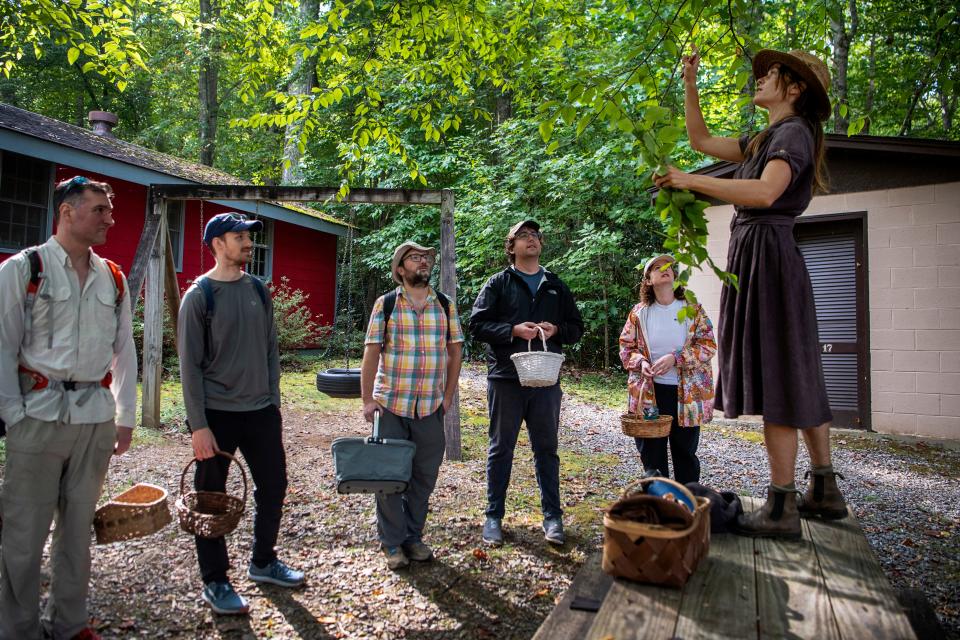
Over the course of the three-hour tour, the foragers sampled items from the ground and trees, discovering surprising like bursts of citrusy flavors from wood sorrel, and after a sniff of a sweet birch branch, learned how the tree bark may be used to make a root beer-like drink called birch beer.
“It was well organized, and everybody had a lot of information. It felt safe, which was good for me,” said Gazieva.
Azarias and Gazieva said they “highly recommend” the experience to others and are considering when they can return to Asheville for another foraging tour but in another season so they can discover different things.
Into the woods
Shaw passed down the knowledge she’d learned over the years living in the Appalachians.
“There’s a big foraging community in Asheville. A lot of people, cultures and communities here are foraging,” Shaw said. “That’s a newer thing but as you interview the old timers and people who’ve been here in these hollars for a while ― I’ve learned so much from them.”
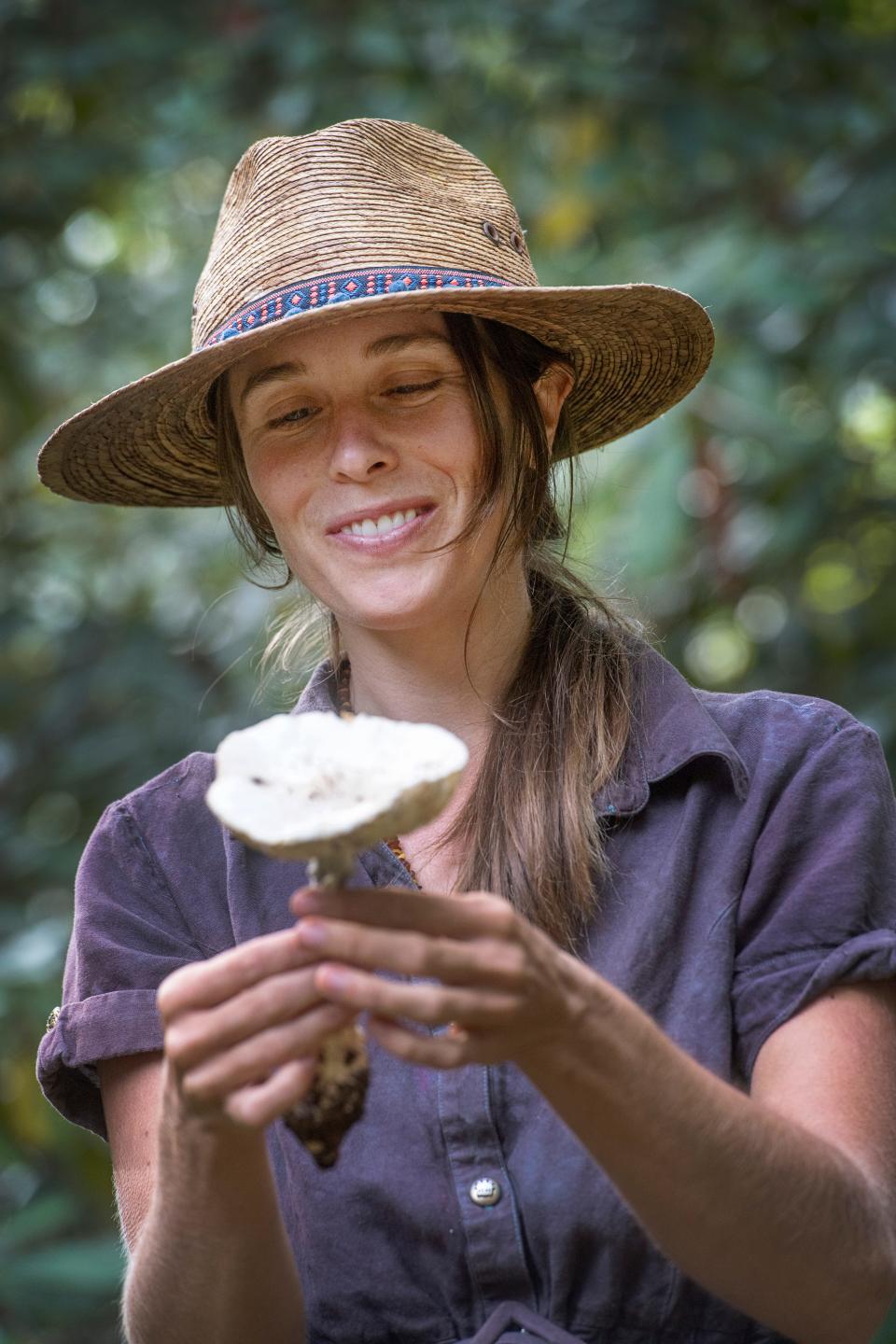
Foragers were equipped with dual knife-brush tools and baskets for collecting their forest finds and learning safety rules.
Rule one: Don’t eat anything without the guide’s approval.
Edible mushrooms, plants and berries offering delicious flavors and health and medical benefits surrounded the foragers, like sourwood tree leaves.
Shaw also pointed out the dangers of the forest, like poison ivy, and their identifying characteristics. She warned of how certain species of fungi can result in various degrees of illness or can be deadly, such as the death cap mushroom.
Foraging on
Shaw said she aims to help guest foragers find a primal connection to nature by examining, harvesting and tasting edible plants and other wild foods.
In 1995, No Taste Like Home founder Alan Muskat created the company due to the growing interest in foraging and to provide a safe, educational and accessible experience to individuals of varying skill levels and abilities.
“We had a 95-year-old in a wheelchair a couple of years ago and she did fine on the tour,” Muskat said. “That’s the great thing about foraging, it appeals to all ages.”
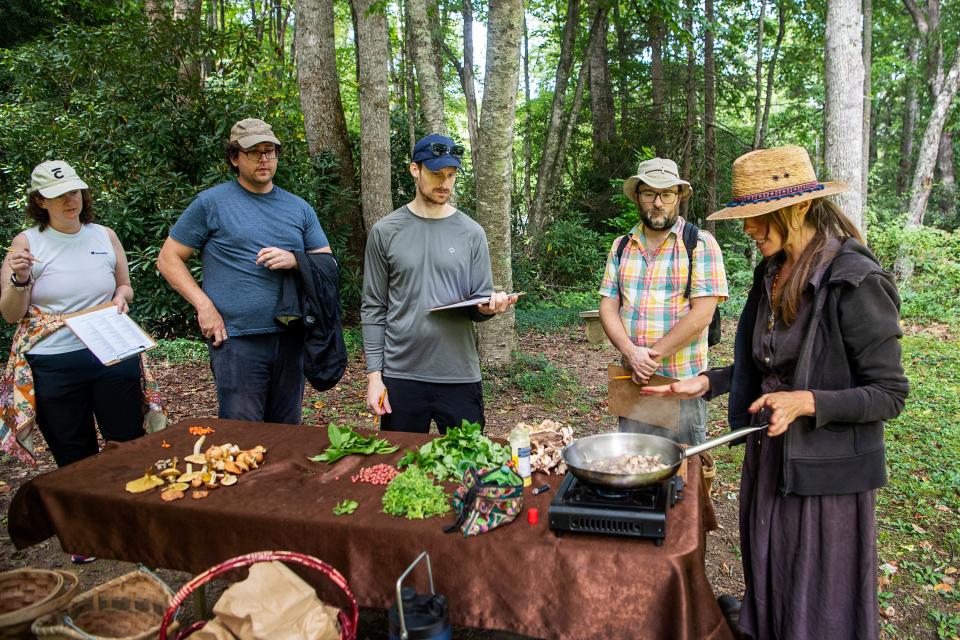
Foraging has a lower physical requirement than hiking, and much can be found without leaving the trail.
Foragers may gain a sense of empowerment that comes from recognizing, picking, identifying and preparing their own food directly from the source, Muskat said. Also, the harvests are full of nutritional perks.
“They’re far more nutritious, the wild versions because they’re growing in the wild, on wild things,” Muskat said. “They’re not grown on sawdust, for example, or maybe given nutrients with plants ― fertilizer and pesticides. These things are artificial, and they also weaken the plants and the same goes for mushrooms.”
Digging deeper into wild foods and foraging
Chris Fairbanks, a West Asheville resident, picked up foraging as a hobby amid the COVID-19 pandemic, given the extra time to observe the mushrooms growing outside his home. He's now a No Taste Like Home season pass holder.
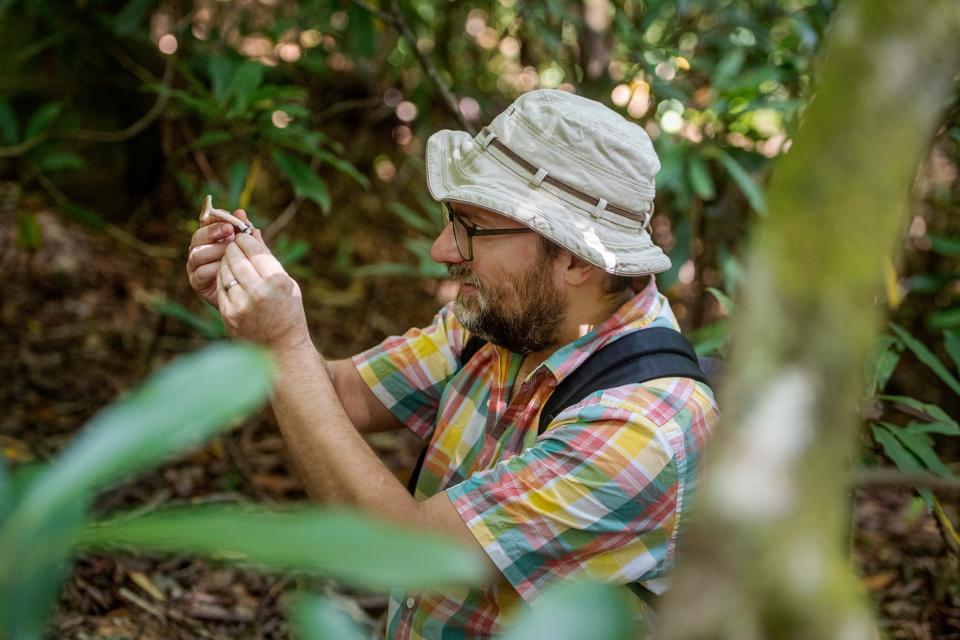
“Some of it’s repetitive but a lot of things keep changing with the season. I’ve been a few times already this year and minus the wood sorrel that’s always out, everything else is different,” Fairbanks said.
No Taste Like Home hosts tours year-round and what’s found changes by season and location. The group rotates trails to provide a new, different experience with plenty to find along the way.
Muskat said foraging tours are easier, more reliable, and safer than going out alone or learning strictly from a book or app.
“Just like any other skill, you don’t earn a skill from a book,” Muskat said. “Like swimming, you have to practice and it’s easier to have someone who can observe what you’re doing and correct you and a book can’t do that either.”
Fairbanks’ knowledge has grown the more he ventures out with the guides, and there’s still much to learn that will come with time and practice.
“Anyone who wants to feel more of a connection to the land they’re living on, I feel like eating off of it is a good way to do that,” Fairbanks said. “This group does a really good job of giving you the tools to bit-by-bit learn something else you can eat. I love it.”
Cooking with wild food harvests
No Taste Like Home’s tour concluded with Shaw, using a camp stove, leading a cooking demonstration incorporating some of the wild foods collected by the group.
The guest foragers were distributed bags of the remaining harvest to take home or take to one of No Taste Like Home’s local restaurant partners, like The Market Place, that will prepare their “catch of the day” ingredients following their tour to be used in a “forage-to-table” meal.
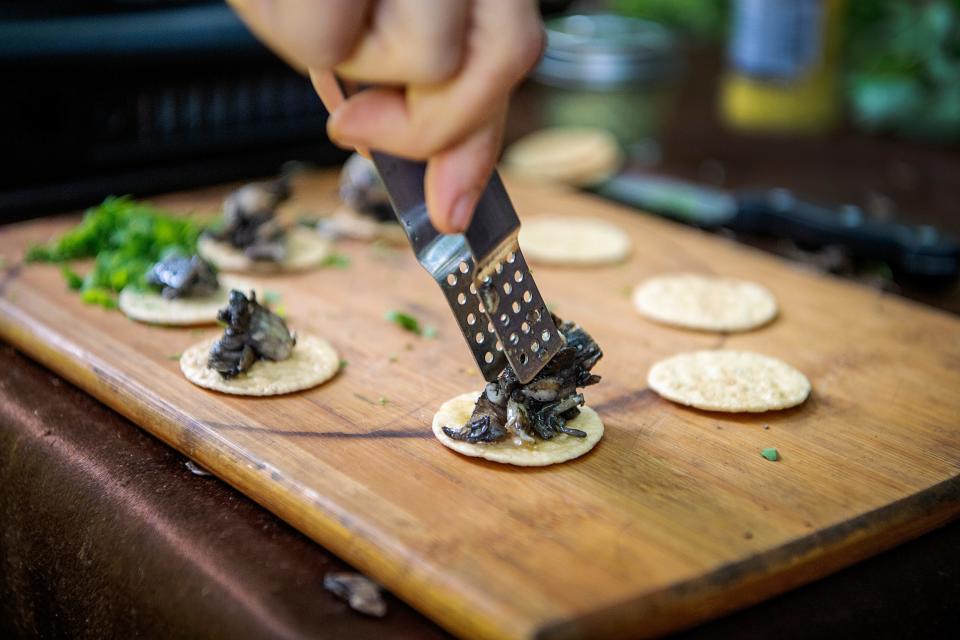
Wild foods at The Market Place
The Market Place’s owner and Executive Chef William Dissen learned to forage on his grandfather’s farm in West Virginia before setting out deeper into the Appalachians.
“I learned that wild foods are super healthy and the flavors you get are like nothing else. I learned to love them,” he said.
Dissen recommends those interested in wild foods join a local foraging club, like No Taste Like Home.
“I think they’ll be surprised about all the wild edibles that are growing everywhere,” Dissen said. “The one thing I always recommend is don’t just go out and pick things haphazardly and eat them. Make sure that you go out with another human being, cross-reference it with another human, and make sure that you verify what you’re eating before you eat it.”
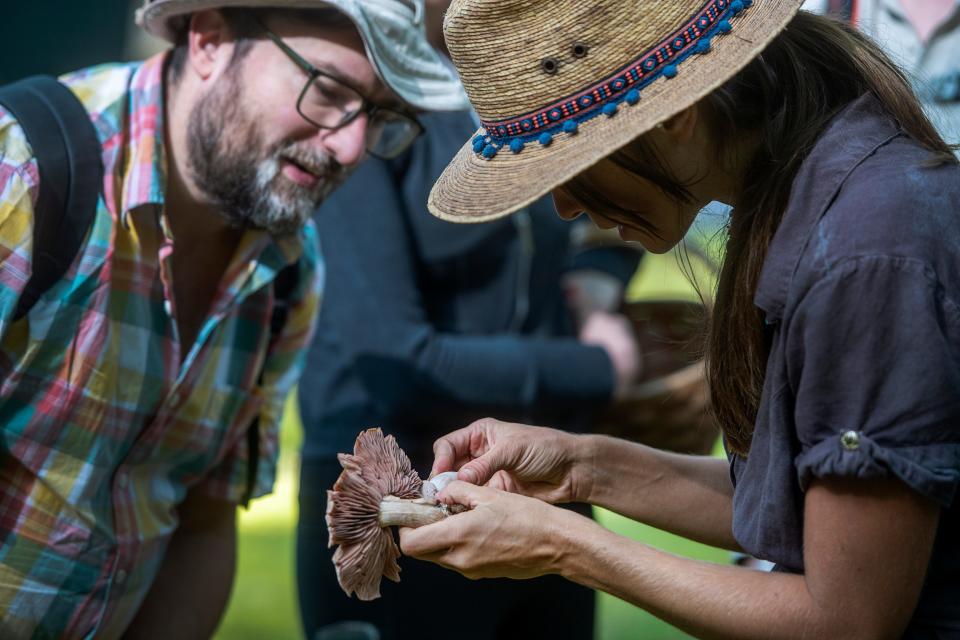
Another way to safely source wild mushrooms is to purchase them at farmers markets from vendors like Black Trumpet Farm, or grocery stores like Earth Fare and Whole Foods.
Dissen said he uses thousands of pounds of wild mushrooms at The Market Place, plus many more sourced from mushroom companies across the region.
“As I moved to Asheville and took over The Market Place, I got introduced to Alan and started going out with him to learn more about wild foods and he changed my mind about how I look at nature and how I purview the forest floor when I go out hiking,” Dissen said. “From that point on, I started using a lot of wild foods in the restaurant.”
Now, there are many fungi-forward dishes featured on the menu each season, like the Red-Wine Braised Lamb Shank Pappardelle that features roasted oyster mushrooms and wild ramp pesto.
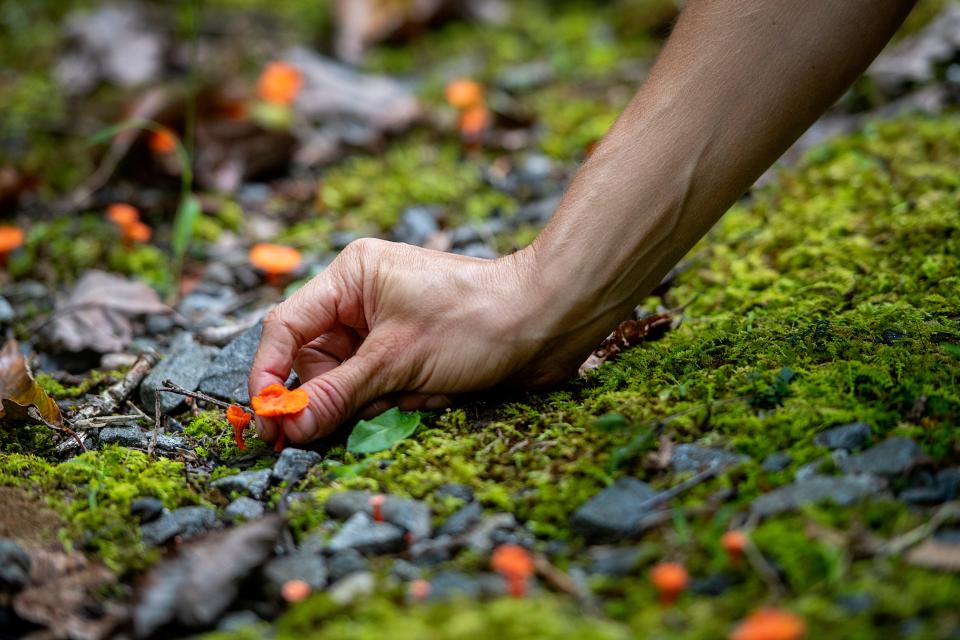
“Greater Western North Carolina area is one of the most biodiverse places in the world and we have amazing ecology here that allows for amazing wild foods to grow,” Dissen said.
Other wild foods Dissen enjoys are ramps, stinging nettles ― antioxidant-rich greens when cooked ― and paw paws, which he described as a cross between a mango and banana.
“Way up in the mountains, in places like Graveyard Fields, there’s wild blueberries growing everywhere. You can literally find snacks on the trailside while you’re out hiking,” Dissen said.
Dissen’s tips for cooking wild mushrooms
The basic way to cook mushrooms is to slice them thin, then cook them with shallots or onions and lots of garlic, Dissen said. Next, add a little bit of white wine and cook it down. Finish it with butter and fresh herbs. The chef recommends serving on toast or fresh pasta.
“The flavor you get off the wild mushroom versus a cultivated mushroom is so much better and so much different, and you’re tasting the terroir of the forest floor you’re harvesting from,” Dissen said.
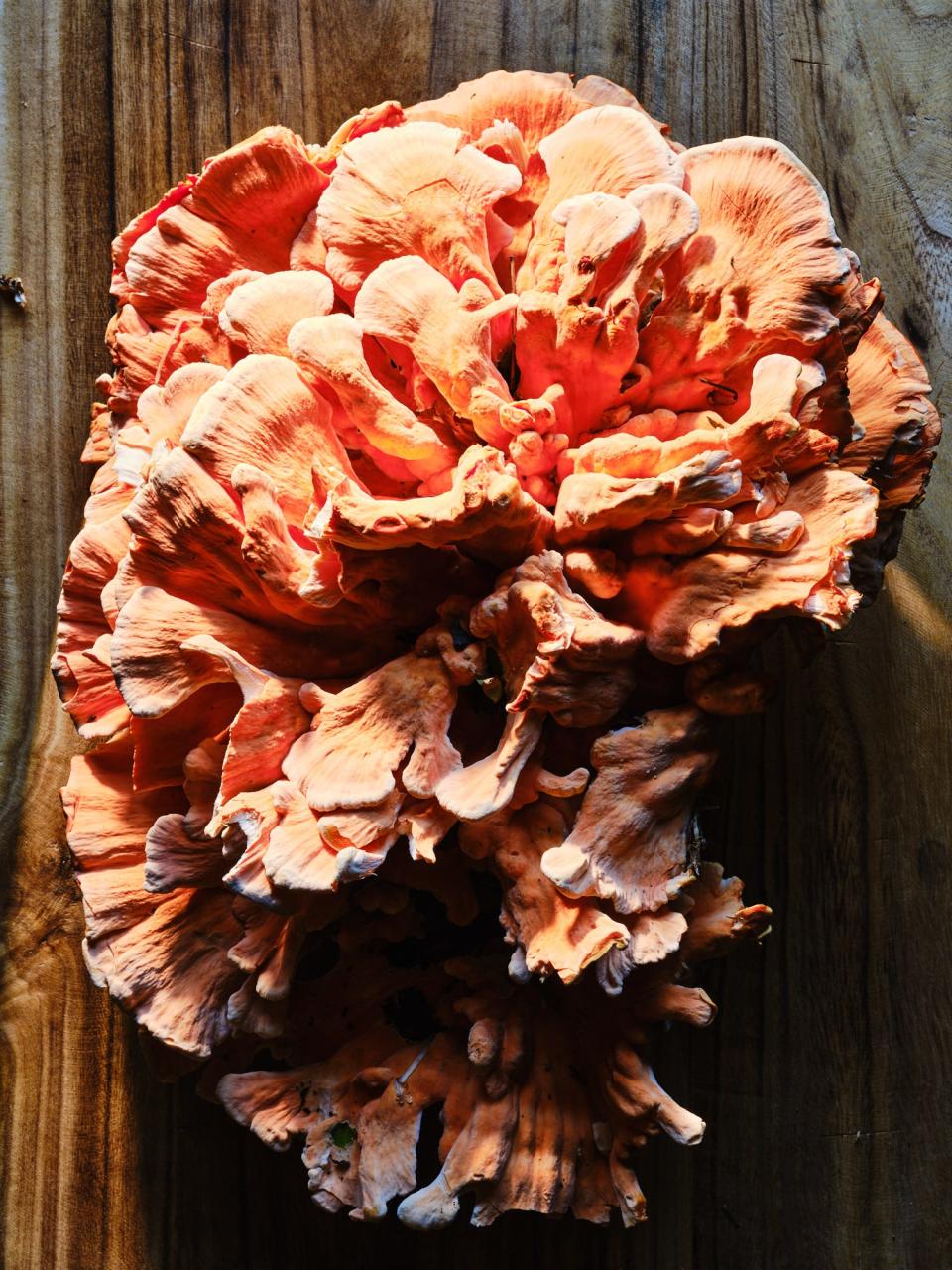
Chanterelle mushrooms have an earth but fruity flavor, he said, and the chef enjoys preparing them with roasted corn and fresh peaches.
“That might sound a little odd to some, the combination of chanterelle, corn and peaches is exquisite,” Dissen said.
Boletes are richer, and the chef likes to cook them down to make a ragu that you might cook with fresh pasta or into a cream-based sauce for mushroom gratin.
Dissen said the Foraged Mushroom Gratin returns annually to The Market Place’s menu for the fall season when wild mushrooms are in full swing.
Chicken of the Woods are heartier, and Dissen prefers to source them when they’re younger and cook them slow and low. They may be grilled to add a bit of smoky flavor and cooked down into a sauce.
The Market Place's Foraged Mushroom Gratin
(Yield 4 portions)
2 tbsp. Olive oil 2 tbsp. Butter 2 qt. Wild Mushrooms, cleaned, large dice 1 cup Shallots, medium dice 1 tbsp. Garlic, minced 1 1/2 cups White Wine 1 cup Heavy Cream 1 tbsp. Basil, chopped 1 tbsp. Parsley, chopped 1 tbsp. Thyme, chopped Salt and pepper to taste
For Parmesan Herb Crust:1.5 cups Panko bread crumbs1/4 cup Parmesan Reggiano1 tsp. Basil, chopped1 tsp. Parsley, chopped1 tsp. Thyme, choppedSalt and pepper to taste
Directions:
Preheat oven broiler to medium high heat.
To prepare the Parmesan Herb Crust, place the panko bread crumbs in a food processor and blend on high to thoroughly process. Add parmesan, herbs & S&P. Taste & adjust seasoning, if necessary. Reserve.
Heat a medium sauté pan over high heat. Add olive oil & 1 tbsp. of butter.
When pan is lightly smoking, add the shallots and sauté for 1 minute, or until golden. Stir in the mushrooms & garlic. Reduce the heat to medium high.
Cover the pan and continue to sauté for 1 minute. Uncover the pan and deglaze with the white wine. Cook, reducing the wine to a glaze & stir in the heavy cream. Reduce by half.
Stir in the remaining butter, herbs & S&P. Taste & reseason, if necessary.
Place mushroom mixture into 4 ramekins & liberally sprinkle with the Parmesan Herb Crust.
Place ramekins under the broiler and cook until the crust is golden brown.
Serve immediately with toasted crostinis.
No Taste Like Home
Info: For more, visit notastelikehome.org.
The Market Place
Where: 20 Wall St., Asheville.
Hours: 5-9:30 p.m. Monday-Thursday; 5-10:30 p.m. Friday and Saturday; 5-9 p.m. Sunday.
Info: For more, visit marketplace-restaurant.com.
Food news you may have missed:
Asheville forager featured on CNN Travel, shares mushroom secret
Gordon Ramsay explores region with Asheville culinary pros on National Geographic show
Garden & Gun magazine honors 2 Asheville 'champions' for conservation work
Tiana Kennell is the food and dining reporter for the Asheville Citizen Times, part of the USA Today Network. Email her at tkennell@citizentimes.com or follow her on Instagram @PrincessOfPage. Please support this type of journalism with a subscription to the Citizen Times.
This article originally appeared on Asheville Citizen Times: Mushrooms grown wild: Expert foraging guides, chef share tips, recipe

